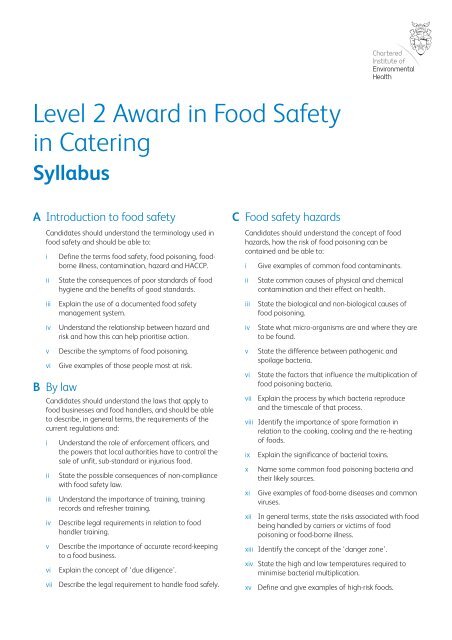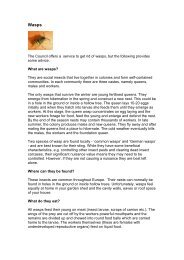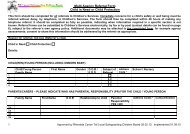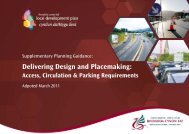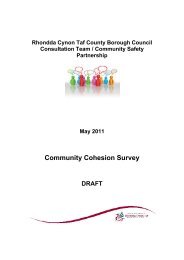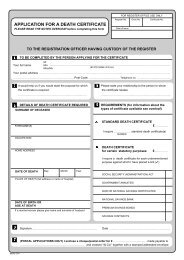Syllabus Level 2 Award Food Safety Catering
Syllabus Level 2 Award Food Safety Catering
Syllabus Level 2 Award Food Safety Catering
Create successful ePaper yourself
Turn your PDF publications into a flip-book with our unique Google optimized e-Paper software.
<strong>Level</strong> 2 <strong>Award</strong> in <strong>Food</strong> <strong>Safety</strong>in <strong>Catering</strong><strong>Syllabus</strong>A Introduction to food safetyCandidates should understand the terminology used infood safety and should be able to:iDefine the terms food safety, food poisoning, foodborneillness, contamination, hazard and HACCP.C <strong>Food</strong> safety hazardsCandidates should understand the concept of foodhazards, how the risk of food poisoning can becontained and be able to:iGive examples of common food contaminants.iiState the consequences of poor standards of foodhygiene and the benefits of good standards.iiState common causes of physical and chemicalcontamination and their effect on health.iiiExplain the use of a documented food safetymanagement system.iiiState the biological and non-biological causes offood poisoning.ivUnderstand the relationship between hazard andrisk and how this can help prioritise action.ivState what micro-organisms are and where they areto be found.vviB By lawDescribe the symptoms of food poisoning.Give examples of those people most at risk.Candidates should understand the laws that apply tofood businesses and food handlers, and should be ableto describe, in general terms, the requirements of thecurrent regulations and:iiiiiiivvviviiUnderstand the role of enforcement officers, andthe powers that local authorities have to control thesale of unfit, sub-standard or injurious food.State the possible consequences of non-compliancewith food safety law.Understand the importance of training, trainingrecords and refresher training.Describe legal requirements in relation to foodhandler training.Describe the importance of accurate record-keepingto a food business.Explain the concept of ‘due diligence’.Describe the legal requirement to handle food safely.vviviiState the difference between pathogenic andspoilage bacteria.State the factors that influence the multiplication offood poisoning bacteria.Explain the process by which bacteria reproduceand the timescale of that process.viii Identify the importance of spore formation inrelation to the cooking, cooling and the re-heatingof foods.ixxxixiiExplain the significance of bacterial toxins.Name some common food poisoning bacteria andtheir likely sources.Give examples of food-borne diseases and commonviruses.In general terms, state the risks associated with foodbeing handled by carriers or victims of foodpoisoning or food-borne illness.xiii Identify the concept of the ‘danger zone’.xiv State the high and low temperatures required tominimise bacterial multiplication.xvDefine and give examples of high-risk foods.
xvi Explain the concepts of ‘contamination’ and‘cross-contamination’.xvii Understand the term ‘cross-contamination’ andhow to prevent it.xviii Understand the reasons for the separation of rawand ready-to-eat foods in storage.xix Understand reporting and remedial procedures.D Taking temperaturesCandidates should understand how to take product andequipment temperatures and should be able to:iiiExplain how probe thermometers should becalibrated, used, cleaned and disinfected.Describe methods of checking and recordingrefrigerator temperatures.E Refrigeration, chilling and coldholding of foodsCandidates should understand how a reduction instorage temperature will minimise bacterialmultiplication and should be able to:iiiiiiivDescribe the temperatures at which chilled foodmust be stored.Describe safe methods of rapid chilling of cookedfood.Understand freezing and the safe storage of frozenfoods.Describe safe methods of defrosting frozen foods.F Cooking, hot holding and re-heatingof foodsCandidates should understand the importance ofhigh temperatures in the supply of safe food and, inparticular, be able to:iiiState the temperatures required to destroy harmfulbacteria or to minimise their multiplication.Explain the risks associated with:• under-cooking of foods• re-heating food• holding food hot.G <strong>Food</strong> handlersCandidates should understand that food handlers canimpose a risk to food safety and be able to:iiiiiiUnderstand the importance of personal hygiene infood handling.Detail the need for, and suitable methods of, handwashing.Describe the importance and properties ofprotective clothing.H Principles of safe food storageCandidates should understand the importance ofutilising appropriate storage conditions for differenttypes of food and should be able to:iiiiiiivvviState the main ways in which food is preserved andhow preserved foods should be stored.Understand the significance and importance of‘use-by’ and ‘best-before’ dates on foods.Understand the principles of stock rotation.Identify the appropriate storage conditions forfrozen, chilled and ambient foods.Understand procedures required for dealing withfoods that may cause allergic reactions.Explain the importance of correct handling,preparation, cooling and processing of food.I CleaningCandidates should understand the importance ofcleaning in food premises and should be able to:iiiiiiivvDescribe acceptable methods of storing anddisposing of waste from food premises.Understand the role of cleaning in preventing foodcontamination.Describe the washing facilities that should beprovided for food and equipment.Explain the terms ‘cleaning’, ‘disinfection’ and‘sterilisation’.Describe how cleaning chemicals, disinfectants andsanitisers are used safely.iiiDescribe methods of monitoring cooking andholding temperatures.viDescribe how clean and suitable cloths should beused for different tasks.ivvExplain the importance of rapid and thoroughre-heating of food.Describe the temperatures at which hot food mustbe stored.viiUnderstand the significance of cleaning schedules.viii Describe the effective cleaning of food storageareas and chillers
J <strong>Food</strong> premises and equipmentCandidates should recognise the need for high standardsfor structure and equipment to promote good hygiene infood premises and should be able to:iiiiiiivvviviiExplain the importance of food premises beingsuitably constructed, fitted out and equipped andthe hazards associated with faulty surfaces andequipment.Identify the essential first aid equipment required forfood premises.Understand the legal requirements in relation tothe construction and cleanliness of the premisesand equipment.Understand the legal requirements in relation to thehygiene facilities to be provided in food premises.Define the term ‘food pest’ and describe theconditions in which pests thrive.Name the different types of common food pests.List the signs of a pest infestation, how they can beprevented and what actions should be taken in theevent of an infestation being discovered.
Training DivisionChartered Institute of Environmental HealthChadwick Court, 15 Hatfields, London SE1 8DJTelephone 020 7827 5800 Training Division (Option 1)Email customersupport@cieh.org Web www.cieh.org/training© CIEH, 2007Printed March 2007Stock Code 2FNSYL


